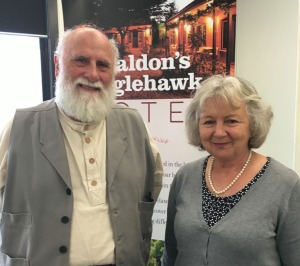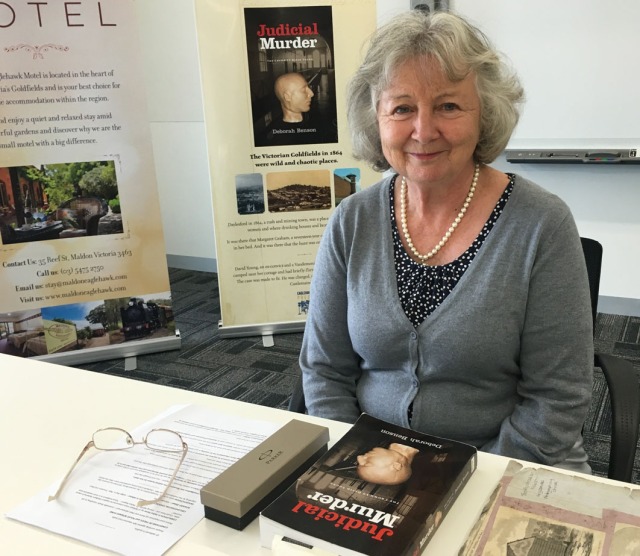Almost a year after my previous post, I am very pleased to introduce Deborah Benson. I met Deborah during a talk she recently gave at Scottsdale Library in Tasmania.
Deborah was inspired to write her first book to tell the terrible tale of David Young, a man she believes was wrongly convicted and executed for the vicious murder of a woman in Daylesford, Victoria in 1864.
Deborah is seeking a posthumous pardon for David Young.
Can you tell me what originally inspired you to write your book, Judicial Murder?
After accidentally coming across the story and getting caught up in the research, I became impassioned to seek justice for David Young. I felt his story needed to be shared and that his side of the story needed to be told.
I attended a Professional Writing Course at Maldon’s Neighbourhood Centre. Our tutor was Josephine Emery – a very experienced and skilled writer. She encouraged me to write Judicial Murder and also edited the book.
Can you describe your writing day? Do you have any rituals, writing processes or methods that help you?
My writing day had no rhyme or reason. My work at the Eaglehawk Motel came first and I fitted the writing in around the demands of the Motel. Having the writing course to attend encouraged me to use my time wisely and to always have something written or ready to be discussed at the class.
My writing area was the front desk of the Motel. This was not ideal as guests and phone calls would interrupt my train of thought and research – through no fault of their own I may add. Extremely difficult circumstances to be creative in and a great deal of patience and determination was required.
How did you go about researching David Young’s story?
My initial research was using newspapers on Trove. This source came up immediately with my search term ‘Margaret Graham murder.’ I conducted further research at the Public Records Office Victoria, seeking out every possible communication related to Young’s trial, incarceration, hanging and the consequences. Police Records were available from The Victoria Police Museum which were essential for the views of the Police involved.
As I wrote, I realised to be authentic to the times I needed to find out about life on the goldfields, what life was like for a constable, Christmas celebrations in the 1860s, what people ate at the time, Christy Minstrels ballads, etc. I read books and used the computer to discover more about events and characters who came up in the case. Everything I found is referenced in the back of the book.
Did you do a detailed outline for your story or did you ‘wing it’?
The story developed as Josie, my writing tutor, said it would. There was no need to write an outline as the research revealed a sequential order of events. I also found that the story began to write itself to a degree. As I wrote, questions would come to me concerning the next step. In a way the writing happened naturally and was not forced or contrived.
How did you decide on your approach to narrating David Young’s story?
Once I realised I was going to write David Young’s story, I knew it would have to be based upon truth. I could not write a fiction story based upon these true events – there would be no point. My aim was to tell David Young’s side of the story. The story had to be real so I created dialogue to enable the reader to connect with David Young. I developed characters who were already in the story and who I had got to know through correspondence from the time.
How have you gone about getting your book into bookstores?
I initially approached my local bookstore and questioned the owner. She suggested the agent we ended up using to distribute books around Victoria and Tasmania. We approached bookstores ourselves. Some accepted the book while others didn’t respond. We are looking for agents in the other states and New Zealand.
I needed to find out about life on the goldfields. What was life like for a constable? What did people eat in the 1860s? How did people celebrate Christmas?
What’s next for you? Do you have any other projects or stories on the horizon?
I do have a children’s book in mind as I was a kinder teacher. My main priority is to follow up with David Young’s exoneration and to share his story as much as possible.
You recently toured Tasmanian libraries and bookshops to promote your book. How did you decide on content for the talks?
I felt the content needed to inform listeners as to how the story came into being, a background on David Young, a brief description as to the murder and damning evidence, what was happening against David Young, including a picture of the police of the time and the justice system.
Chris [Deborah’s partner] reads from the Hanging Scene. He does it so well and it is a nice change from my voice. I wanted my approach to be relaxed as possible as I am not a seasoned speaker so it suited me too to have Chris do the reading!
What helped me to have the confidence to be in front of strangers, talking about my book, was I was happy to be talking about David Young’s story and to be sharing it with interested people, rather than facing strangers who were all staring at me! This small change of attitude really helped to relax me. Chris is also a good critic and we discussed ways to improve my speaking.
Can you tell me something about EagleHawk Press – did you set it up to publish specific titles? Would you like to comment on the experience of running a small publishing house?
Eaglehawk Press was developed to publish and publicise our books. It is a small concern at the moment but we have learnt a great deal from our own experiences. We are looking to open up our services to other writers.
If you could travel back in time to the moment before you published your manuscript, what advice would you give yourself?
Be thorough, be patient. Take advice. Give yourself a reasonable timeline as writing and publishing all takes time.
The 28th of December, 1864 – a most brutal murder was committed in the goldfields town of Daylesford, Victoria.
The victim was a young wife of six weeks, only 17 years old, viciously attacked in her bed. The hunt was on to find the perpetrator. Eventually the constabulary settled on David Young; he was tried, convicted and executed.
But it would appear that everything about that conviction was unsound. How could this happen? Judicial Murder is the true story of those events and the desire to address a dreadful wrong.

Deborah with her partner, Christopher Creek. Christopher read an extract from David Young’s Hanging Scene during the talk at Scottsdale Library
Deborah’s book has been nominated in Best True Crime Book and Best Debut Novel categories for the Sisters in Crime Davitt Awards, to be announced in August, 2016. Find out more about the book on the Eaglehawk Press website.
There is also a Facebook page for The Exoneration of David Young. The page contains information about any developments, venues and information regarding Judicial Murder, The Crown vs David Young and David Young’s case.
Deborah is hoping to do more guest speaking at libraries in Victoria, including a talk at Castlemaine Library on August 11th, 2016.
Contact Eaglehawk Press for information regarding Judicial Murder or writing services Deborah and Christopher can help with.
